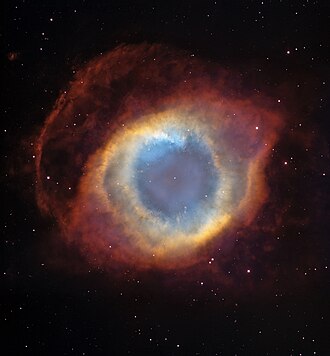Nebulosa de Hélix

Nebulosa de Hélix, também conhecida como Nebulosa da Hélice, A Hélix ou NGC 7293 é uma nebulosa planetária localizada na constelação de Aquarius (ou Aquário). Também foi apelidada de "Olho de Deus" devido ao seu formato visto da Terra.[1]
Descoberta por Karl Ludwig Harding, provavelmente antes de 1824, essa nebulosa é uma das mais próximas da Terra.[2] Sua distância da Terra é de aproximadamente 700 anos-luz (215 parsec). Ela é muito parecida com a nebulosa do anel, e têm tamanho, idade e características físicas parecidos à nebulosa do Haltere, sendo diferentes apenas em suas proximidades e aparência de um ângulo equatorial.[3]
Durante a chuva de meteoros Leônidas em novembro de 2002, os controladores viraram o Hubble para protegê-lo por cerca de meio dia. Coincidentalmente, a Nebulosa Hélix estava quase que exatamente na direção oposta à chuva de meteoros, assim o Hubble pôde fotografar a nebulosa.
Nebulosas planetárias como a Hélix são formadas no final da vida de uma estrela (como o Sol) por uma corrente de gases que escapam da estrela morrendo.
Ver também
[editar | editar código-fonte]Referências
- ↑ «NASA captura incrível imagem do `Olho de Deus`». Exame. 6 de outubro de 2012. Consultado em 21 de maio de 2021
- ↑ Hora, Joseph L.; Latter, William B.; Smith, Howard A.; Marengo, Massimo (2006). «Infrared Observations of the Helix Planetary Nebula». The Astrophysical Journal. 652 (1). pp. 426–441. doi:10.1086/507944
- ↑ O'Dell, C. R.; Balick, B.; Hajian, A. R.; Henney, W. J.; Burkert, A. (2002). «Knots in Nearby Planetary Nebulae». The Astronomical Journal. 123 (6). pp. 3329–3347. doi:10.1086/340726
Ligações externas
[editar | editar código-fonte] Media relacionados com Nebulosa de Hélix no Wikimedia Commons
Media relacionados com Nebulosa de Hélix no Wikimedia Commons
Text is available under the CC BY-SA 4.0 license; additional terms may apply.
Images, videos and audio are available under their respective licenses.
